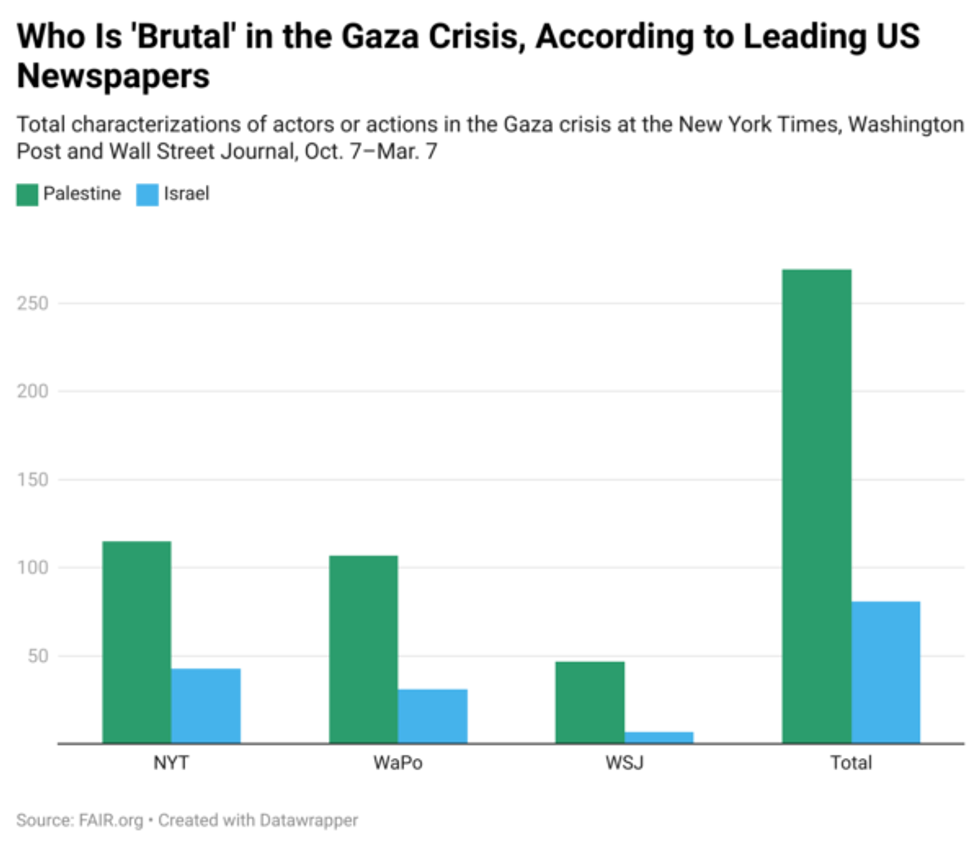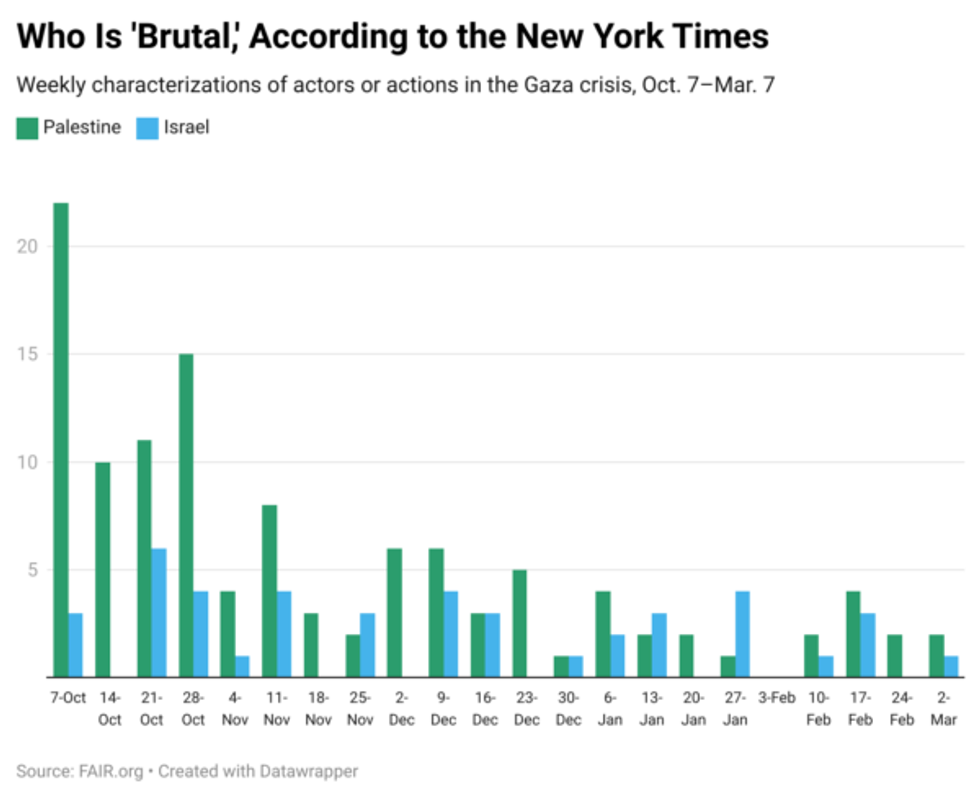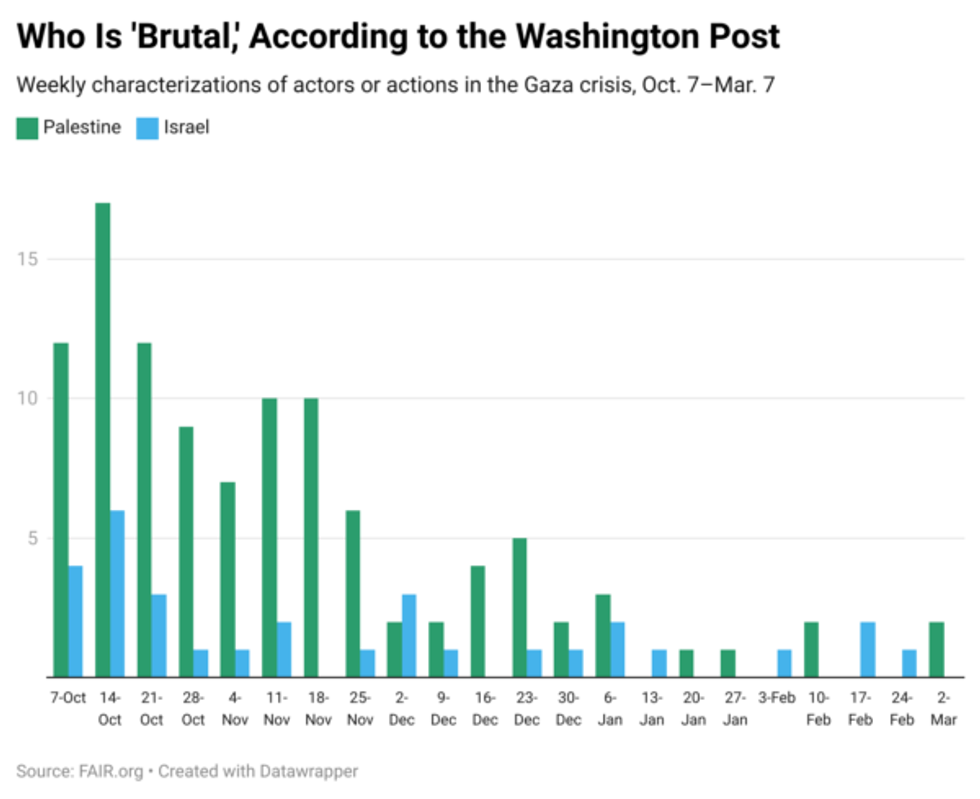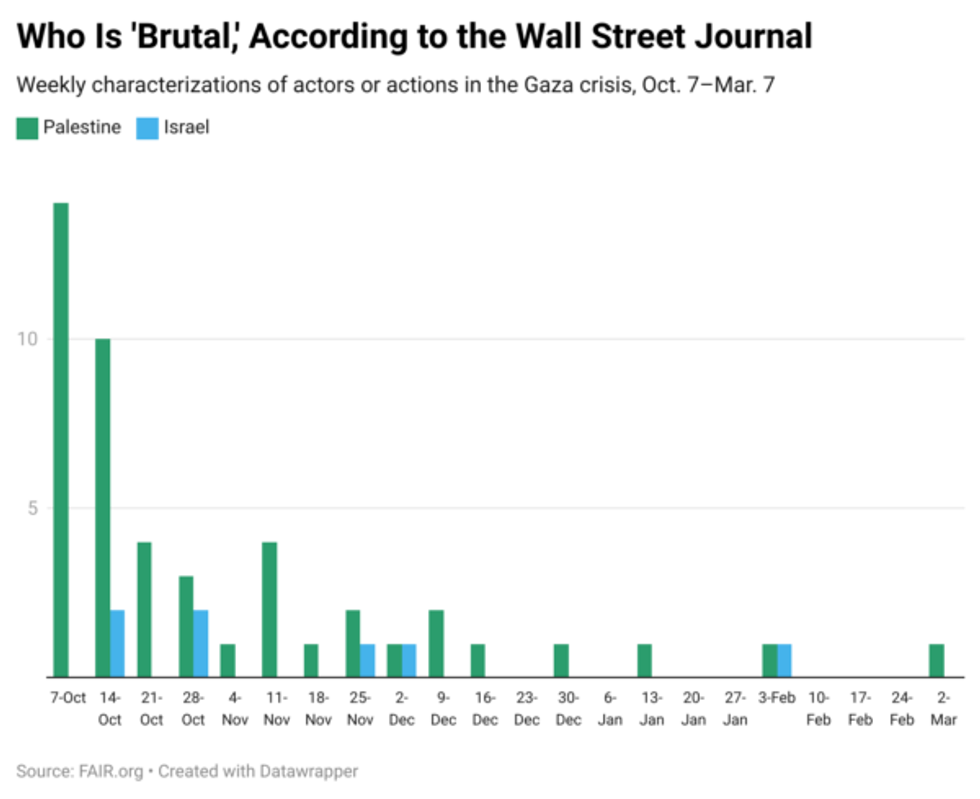Looking at all attributions, 77% of the time when the word “brutal” was used to describe an actor in the conflict, it referred to Palestinians and their actions.
But to U.S. newspapers, brutality appears to be less about actions or outcomes than about identity.
Attributing ‘Brutality’
FAIR recorded each instance in which The New York Times, Washington Post, and Wall Street Journal used the word “brutal” (or variants like “brutally,” “brutality” etc.) to characterize Palestinians or Israelis, over the five-month period from October 7 to March 7.
Using the search terms “brutal” and “Israel” in the Nexis and Factiva news archiving services, FAIR distinguished between characterizations made by sources and those in a journalist’s own voice. When the word was used by a source, FAIR noted their occupation. FAIR also noted if a “brutal” claim came in an opinion piece or a news story.
If an occurrence of “brutal” was not clearly attributed to a party in the conflict, it was labeled “unattributed” and not included in the data analysis. For instance, the statement “most news and commentary describes the war in Gaza as the latest brutal episode in the conflict between Israelis and Arabs” (Wall Street Journal, 11/6/23) does not clearly attribute “brutal” to a particular side. On the other hand, if a statement called both parties “brutal”—such as a Palestinian source’s statement, “Fear makes us brutal to each other” (New York Times, 1/31/24)—then it was counted as two instances, one for each party.
Total Characterizations

Looking at all attributions, 77% of the time when the word “brutal” was used to describe an actor in the conflict, it referred to Palestinians and their actions. This was 73% of the time at the Times, 78% at the Post, and 87% at the Journal. Only 23% of the time was “brutal” used to describe Israel’s actions—even though Israeli violence was responsible for more than 20 times as much loss of life.
Out of the 350 “brutal” mentions that were analyzed, 246 came from straight news stories—in quotes from sources and in journalists’ own words—while 104 came from op-eds. The lopsided rate at which “brutal” was used in op-eds to characterize Palestinians over Israelis was exactly the same as the supposedly straight news stories: 77% of “brutal” mentions in news reports and 77% in op-eds were applied to Palestinians.
That publications were just as likely to describe Palestinians, as opposed to Israelis, as “brutal” in a straight news story versus an op-ed indicates a blurred distinction between these categories. Describing violent actors or their actions as “brutal,” after all, is an opinion, not a fact. That opinion may be well-justified, but it remains subjective.
Whatever concern these publications may have for Israel’s victims isn’t enough for them to openly question, in a meaningful and timely way, whether Israel’s stated goal of destroying Hamas is its actual one.
The New York Times, in fact, distributed an internal memo in November (leaked to The Intercept, 4/15/24) instructing reporters to refrain from using “incendiary” language in their reporting on the war on Gaza, because “heated language can often obscure rather than clarify.” The memo highlighted the risks of double standards, asking, “Can we articulate why we are applying those words to one particular situation and not another?”
Our study found a clear pattern of the tendentious word “brutal” being applied overwhelmingly to one side of the conflict, supporting the concerns that Times staffers expressed to The Intercept that the memo—which also prohibited the use of the term “occupied territory”—reflected a deference to Israeli talking points under the guise of journalistic objectivity.
Reflexive Inoculation

It took until the week of November 25 for the Times and December 2 for the Post to publish more characterizations of Israel as “brutal” than of Palestinians in a week. But that inversion only happened a few more times. From that point on, as the death toll in Gaza climbed to over 30,000 and children began to die not just from bombs but also famine, the frequency of “brutal” characterizations at the two papers dropped overall, and Palestinians were still more likely than Israel to be called “brutal” each week.
Meanwhile, as “brutal” references diminished at the Journal as well, there was virtually no shift in its application. From the week of December 9 through the end of the collection period, the Journal only characterized Israel’s actions as “brutal” once—versus seven times for Palestinian actions.
Much of the imbalance has to do with how often journalists reflexively—and lazily—inject “brutal” into phrases like “in the wake of Hamas’s brutal attack on Israel” (e.g., New York Times,10/30/23, 1/2/24) or “following Hamas’s brutal assault” (e.g., Washington Post, 10/17/23, 10/19/23). Reporters seemed to want to inoculate themselves against charges of being insufficiently anti-Hamas, while at the same time giving their audience the semblance of context.
Describing Israel’s actions as a “response” to “brutal” Palestinians helps paint a picture in readers’ minds that the scale of destruction in Gaza is an unfortunate but natural result of the October 7 Hamas attack.
We now know that some of the most horrific atrocity claims that came out of Israel following the October 7 attack were fabrications or embellishments: There were no beheaded babies (FAIR.org, 3/8/24), there’s no evidence of systematic rape by Hamas (Electronic Intifada, 1/9/24; Intercept, 2/28/24), and at least some of the bodies burned beyond recognition—both Israeli and Palestinian—were killed by Israeli weapons (FAIR.org, 2/23/24).
But assume that journalists didn’t know this. Isn’t Israel’s well-documented intent to collectively punish the entire 2.2 million person population of Gaza through indiscriminate bombing and starvation, killing more children under the age of 10 than the number of people (soldiers and civilians) killed in total in the October 7 attack, at least equally deserving of the label “brutal”?
That top U.S. newspapers have used the term more than three times as much to describe Palestinian actions than Israeli ones—a cruel inversion of the actual death toll of the conflict—illustrates that their humanitarian concerns are not universal.
Consider the actual meaning of “brutal,” which Merriam-Webster defines as “suitable to one who lacks intelligence, sensitivity, or compassion: befitting a brute,” and “typical of beasts.” These newspapers’ selective use of the word echoes Israeli President Isaac Herzog’s statement that Palestinians are “human animals.”
‘Brutal’ Attack, ‘Massive’ Response

Statements characterizing the October 7 attack as “brutal” were often followed by neutral descriptions of the Israeli assault, even in articles ostensibly concerned with the Palestinian situation.
A piece by the Times’ editorial board called “The Only Way Forward” (11/25/23), for example, laid out the paper’s view of how to resolve the Israel/Palestine conflict. It used “brutal” to describe Palestinian actions, but the more neutral “massive” to describe Israeli ones:
The brutal attack by Hamas on October 7 and the massive Israeli retaliatory assault on Gaza have already led to too much death and destruction, and have ignited communal hatreds in the United States and beyond.
The Post (11/27/23) used a similar frame:
Israel has mounted a massive assault on the densely populated Gaza Strip, killing more than 13,000—including thousands of children—since October 7, when the Palestinian militant group Hamas launched a brutal cross-border assault on Israel, killing about 1,200 people—including dozens of children—and taking about 240 people into Gaza as hostages.
Note that the assault that by the Post‘s own reckoning killed two orders of magnitude more children was not the one that the paper thought deserved the label “brutal.”
The Journal (10/17/23) used the same frame in an op-ed headlined “Israel Must Follow the Laws Hamas Violates: But the Jewish State Isn’t Culpable for Its Enemy’s Using Gazans as Human Shields”:
The brutal slaughter of Israeli civilians has thrown Hamas’s advocates on the defensive, but if Israel is blamed for massive civilian casualties, this could change.
These statements, which range from stale lamentations of the conflict’s death toll to purely aesthetic concern for Israel’s public image, seem sympathetic at first blush. In fact, they really act as a sort of stress-test for the dehumanizing logic underpinning Western reporting on Israel’s war on Gaza, especially in the first few months after October 7.
In these cases, affective language is still only applied to Palestinian, not Israeli, violence. The extreme gore in Gaza that the world bears daily witness to apparently did not warrant a description as emotive as “brutal.” And whatever concern these publications may have for Israel’s victims isn’t enough for them to openly question, in a meaningful and timely way, whether Israel’s stated goal of destroying Hamas is its actual one.
Describing Israel’s actions as a “response” to “brutal” Palestinians helps paint a picture in readers’ minds that the scale of destruction in Gaza is an unfortunate but natural result of the October 7 Hamas attack—as though Israeli forces hadn’t killed more than 10,000 Palestinians, including more than 2,000 children, prior to October 7 in the 21st century. Add to this the logic of the “human shields” excuse, and it suggests that there’s no Palestinian death toll high enough to merit rhetorical condemnation from these publications.
‘A Brutal, Ugly, Inhumane People’

The sources quoted by the Times, Post, and Journal, when they called one side of the conflict “brutal,” were talking about Palestinians 64% of the time. But that was less lopsided than when reporters for those papers were applying the term in their own voice—when they used “brutal” 83% of the time in reference to Palestinians.
The Times, which urged its journalists not to use emotional phrases in their own voice, or “even in quotations”—suggesting there might be more leeway in such an instance–once again did not follow its own guidelines. When the paper used the term “brutal,” reporters applied it to Palestinian actors or actions 79% of the time when writing in their own journalistic voice, and 61% of the time in quotations.
Two categories of sources were the most frequently quoted: foreign government officials and U.S. government officials, which made up 28% and 27% of total sources, respectively. Quotes from foreign government officials were roughly evenly split between calling Palestinians and Israelis “brutal.” These sources included Israeli Defense Force officials, on the one hand, who made statements like “Hamas seeks to deliberately cause the maximum amount of harm and brutality possible to civilians” (Washington Post, 11/10/23). On the other hand, President Lula Da Silva of Brazil (New York Times, 2/18/24) remarked on Israel’s actions, “I have never seen such brutal, inhumane violence against innocent people.”
The Russian invasion of Ukraine demonstrated Western media’s capacity to cover civilian suffering with sensitivity and empathy—when that suffering is caused by an official U.S. enemy. But with military campaigns waged by the U.S. and its allies, media’s humanitarian concerns tend to fade.
Quotes from U.S. government officials included statements from President Joe Biden (Wall Street Journal, 12/14/23): “Nobody on God’s green Earth can justify what Hamas did. They’re a brutal, ugly, inhumane people, and they have to be eliminated.” National security advisor Jake Sullivan (New York Times, 11/28/23) described Hamas as the “architects” of a “brutal, bloody massacre.”
The only two U.S. government sources to call Israelis “brutal” were Sen. Bernie Sanders (I-Vt.) (Washington Post, 1/4/24), who called Israeli violence an “illegal, immoral, brutal, and grossly disproportionate war against the Palestinian people,” and the White House interns who issued a statement (Wall Street Journal, 12/8/23) saying they were “horrified” by both the “brutal October 7 Hamas attack” and “the brutal and genocidal response by the Israeli government.”
As FAIR (3/18/22) has noted, the Russian invasion of Ukraine demonstrated Western media’s capacity to cover civilian suffering with sensitivity and empathy—when that suffering is caused by an official U.S. enemy. But with military campaigns waged by the U.S. and its allies, media’s humanitarian concerns tend to fade. The uneven deployment of “brutal” seems like a clear case of Western media not just shielding a U.S. ally from justifiable criticism, but actively inciting public hatreds of Palestinians by portraying their violence as exceptionally inhumane despite paling in comparison to that of their colonial oppressor.






